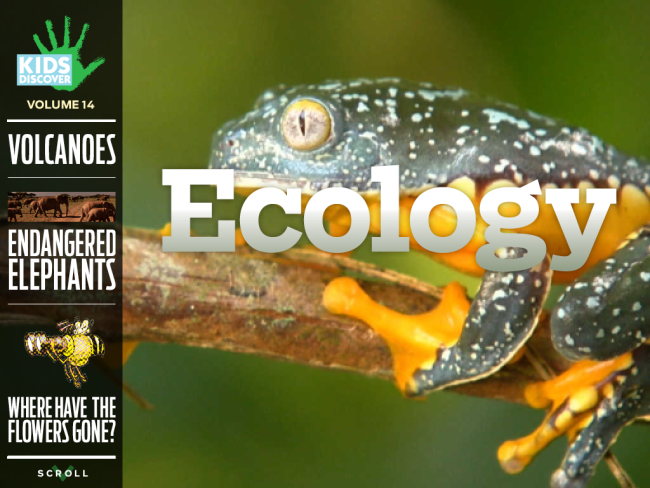Elephants. Tigers. Gorillas. Pandas. Blue Whales. What do these amazing creatures have in common? They are some of the biggest, coolest, and most loved animals on the planet. They are all also endangered species.
An animal or plant is endangered when there are so few left alive on the planet that the entire species is in danger of vanishing forever. When a species is completely gone—and not a single one survives anywhere on Earth—it is considered extinct. Unfortunately, one out of every eight species of birds, one in four mammals, one in three amphibians, and one in five plants are endangered.

Many of the animals pictured here—from the American bison to the polar bear—are on the IUCN Red List, the International Union for Conservation of Nature’s list of globally endangered, threatened, and vulnerable species. (Angela Waye/ Shutterstock)
Scientists estimate there are 7 to 10 million species on Earth. The sum total of all these species is called the Earth’s biodiversity. Biodiversity includes an incredible range of living organisms—from centipedes to dolphins to rattlesnakes. How did there get to be so many species? It didn’t happen over night.
The Earth is mind-blowingly ancient—about 4.5 billion years old. And life on Earth has been around for over 2 billion years. From the earliest one-celled creatures, species have evolved in astonishing ways. Just think about legs for a second. There are four-legged creatures (lions, dogs, elephants), eight-legged ones (spiders), two-legged (pigeons, people), and no-legged (snakes, worms, whales). The famous biologist Charles Darwin once called the variety of life on Earth “endless forms most beautiful.” The world’s species have evolved and adapted to survive in all kinds of environments and ecosystems. They live in oceans and deserts, in treetops and caves, almost anywhere on Earth you can think of.

This Galápagos sea lion is categorized as endangered on the IUCN Red List. In the 19th century, the biologist Charles Darwin developed his theory of evolution after visiting the Galápagos Islands and saw how species had adapted to conditions on the different islands.
(Longjourneys/ Shutterstock)

Polar bears use the summer sea ice in the Arctic as a platform for hunting seals. But due to global warming, this specialized habitat is shrinking. Now listed as “threatened” under the U.S. Endangered Species Act, the polar bear was the first species added to list because of the risk posed by global warming. (FloridaStock/ Shutterstock)
Of course, there have been LOTS of changes to the world’s biodiversity over time. Part of the process of evolution means that some species will go extinct and new ones will evolve to fit into changing environments. But that process normally happens over very long periods of time. Typically, only a few species go extinct over the course of 100 or even 1,000 years.
However, during Earth’s history there have been some extreme events that have killed off large numbers of species. These events are called mass extinctions. One mass extinction you probably know about is the extinction of the dinosaurs. A catastrophic event—most likely a large asteroid slamming into Earth 65 million years ago—created such havoc that 75 percent of the world’s species went extinct. There have been five mass extinctions in the history of our planet.
Unfortunately, if you look at the rate at which animals have been going extinct over the past 500 years and the growing number of species that have become and are becoming endangered, it looks like we are at the start of another mass extinction. In fact, some scientists call the time we live in the Sixth Extinction. What is the extreme event that is causing the Sixth Extinction? The answer is us: human beings.

EXTINCT. The large bird in this painting from the 1620s is the extinct dodo. The dodo was a flightless bird that lived only on the island of Mauritius in the Indian Ocean. When European explorers landed on the island in the mid-1500s, they began hunting the dodo for food and chopping down its forest home. Within 100 years of its first contact with humans, the dodo was extinct. (The dodo here may have been living in a royal zoo in Europe when it was painted.) (Image via Wikipedia)

EXTINCT. The Tasmanian tiger looks like a mashup of a tiger and a wolf. But it is more closely related to kangaroos. Like kangaroos, Tasmanian tigers were marsupials with pouches on their bellies in which they raised their young. When settlers arrived on the island of Tasmania in the 1800s, Tasmanian tigers were treated like pests and the settlers hunted them to extinction. The last Tasmanian tiger to be seen alive died in a zoo in 1936. (Image via Wikipedia)

When a species no longer lives in a particular part of its range, it is considered “locally extinct,” or extirpated. An example of that is the wolf in most parts of the United States, Mexico, and Europe. The wolf is not extinct but has been extirpated from many areas where it once lived. Yellowstone National Park was one such area. In the 1990s, wildlife biologists brought wolves from Canada to live in Yellowstone. Today, about 300 wolves make Yellowstone their home. (Holly Kuchera/ Shutterstock)
Most people love animals, but a lot of things we do as humans are not good for other species. Here is a list of the main reasons people cause other species to become endangered:
–Destroying or damaging habitats
–Overhunting, overfishing, and poaching
–Introducing invasive species.
–Polluting
–Taking animals out of the wild for the exotic pet trade
–Contributing to climate change
By reversing these trends, we may be able to stop the Sixth Extinction. But it is not going to be easy.
Habitat destruction is the biggest reason that species become endangered. One thing that’s important to remember is that species have evolved to live in particular habitats and ecosystems. Forest animals can’t survive in deserts. Fish can’t live out of water. And a freshwater fish can’t survive in salt water. When we take away or damage an animal’s habitat, it can’t just move somewhere else.

There was once a forest here. The trees were cut to make timber for buildings and pulp for paper. Over the last 500 years, people have chopped down one-third of the world’s forests. (TFoxFoto/ Shutterstock)

Asian elephants used to live in low-growing forests all the way from Iraq to China, but people have taken over much of their habitat. Now only about 30,000 Asian elephants survive in the wild, less than half as many as 50 years ago. (Ekkachai/ Shutterstock)

The hawksbill sea turtle is a critically endangered species. These sea turtles find a lot of their food in coral reefs, a vanishing and endangered underwater habitat. They lay their eggs on tropical beaches—but more and more of these beaches have been taken over for tourism and development. (Rich Carey/ Shutterstock)
To save endangered species from extinction, their habitats must be protected. One way to protect important ecosystems is to create national parks, wildlife reserves, and marine protected areas. Yellowstone National Park in Wyoming, Montana, and Idaho is one of the largest relatively untouched habitats in the deciduous forests of the Northern Hemisphere. Yellowstone is home to endangered and threatened species including grizzly bears, lynx, and gray wolves. Around the world, over 12 percent of the Earth’s land area is under some form of protection. Many nations are now protecting ocean areas, too. The small Pacific island nation of Kiribati recently created the Phoenix Islands Protected Area which covers an ocean area the size of California—and is home to some of the world’s most biodiverse coral reef habitats.

Did you know? Over one-third of the land on our planet is used for farming and ranching. This is a picture of 650 square miles of Amazon rain forest taken from a NASA satellite. The left side is what the area looked like in 1975. The right side is what that same area looks like today. Here’s what the NASA Earth Observatory had to say about this: “Settlers cleared the area by first cutting and then burning the forest. As farmed lands grew larger and closer together, they began to merge into a large area of deforestation.” (Image via Nasa)

The Kerinci Seblat National Park in Indonesia is home to five volcanoes, rare tigers, elephants, rhinos, sun bears, flying foxes, and clouded leopards, as well as the corpse flower, the world’s largest (and worst-smelling) bloom. The young Malayan tapir shown here lives in a zoo, but wild tapirs are among the many endangered species that thrive in the protected forests of Kerinci Seblat. (Arun Noisri/ Shutterstock)

This young Sumatran orangutan lives in Indonesia’s Gunung Leuser National Park. Sumatran orangutans are critically endangered and only about 7,000 survive in the wild. (Image via Wikipedia)

Manú National Park in Peru is one of the most biodiverse national parks in the world, with 20,000 plant species, about 1,000 species of birds, and more than 1,000 species of butterflies. One of the most unusual creatures that makes Manú home is the endangered giant river otter. (ostill/ Shutterstock)
Many species are now extinct because they were hunted until there were none left. One of the main threats the world’s five rhino species face is poaching. Even though it is illegal to kill rhinos, poachers hunt them for their horns—and they can sell the horns for lots of money because some people believe rhino horns can cure diseases. In fact, the horns are just made of keratin, the same stuff your hair, your fingernails, and horse hoofs are made from. The rhino horns won’t cure you of anything. So how do you protect rhinos? One way is having more wildlife police and another is developing crime-solving techniques to help catch poachers. Wildlife cops have made a rhino DNA database to help bust poachers.

At the Mkomazi Rhino Sanctuary in Tanzania, endangered black rhinos are protected from poachers and have habitat to roam. (Jiri Balek/ Shutterstock)
Another serious problem facing the world’s species is overfishing. Humans have been taking more fish out of the ocean for food than the seas can naturally produce. That means, compared to 200 years ago, there are a lot less fish in the sea. Today, about 1 in 20 fish species are endangered. One example is the bluefin tuna. The Atlantic bluefin tuna is slow to grow, but it can get big, as long as 10 feet, and weigh over 1,000 pounds. The problem for these fish is that about 50 years ago, people discovered they were delicious to eat and their population was radically reduced by overfishing. Many countries now have rules about how many bluefin tuna can be caught. By reducing the total catch, the Atlantic bluefin tuna population may have a chance to recover.

Torpedo-shaped and very fast, bluefin tuna can retract their fins to reduce drag when they have a need for speed. When chasing prey, they reach speeds up to 45 mph. (Ugo Montaldo/ Shutterstock)
You would think that loving animals would help species survive. But sometimes wildlife can be “loved” into extinction. People who buy exotic pets are often unwittingly buying endangered animals that have been taken out of the wild. Parrots in particular have been hard hit by “love” from pet owners and the illegal pet trade. So many parrots have been taken out of the wild to live in private cages that some species are now extinct and others survive in very small numbers. The sale of endangered wildlife is outlawed in most places, but wildlife smugglers still grab tens of thousands of parrots, rare turtles, threatened tropical fish, and even tigers and primates, which can be sold illegally for thousands of dollars.

The hyacinth macaw is the world’s largest parrot. Playful and smart, these big blue parrots live in open areas next to forests in Brazil and eat the fruits of palm trees. So many were taken from the wild and sold as pets that only a few thousand survive in their native habitat. (worldswildlifewonders/ Shutterstock)

In Madagascar, the ring-tailed lemur is facing a triple threat. 1. The lemurs’ forest home has shrunk due to logging. 2. They are being illegally captured and sold as pets. 3. People are hunting lemurs and eating them for food. Of 104 lemur species on Madagascar, 94 are at risk of extinction. (Micha Klootwijk/ Shutterstock)

Native to the tropical forests of Indonesia, Malaysia, Thailand, and Singapore, the slow loris is the world’s only venomous primate. Despite their toxic bite which can protect them from predators, they are endangered by the illegal pet trade. After taking baby lorises out of the wild, animal poachers will clip out their teeth to stop them from biting—and the lorises frequently die or get sick from the procedure. Sadly, viral videos on the Web—showing “cute,” captive lorises—are fueling the illegal trafficking. (Image via Wikipedia)
Illegal poaching and wildlife trafficking are crimes. But other things people do that threaten wildlife can be accidental. For example, planes and boats can travel anywhere on the planet. Sometimes species that don’t belong hitch a ride and end up causing HUGE problems when they arrive in a new place. Such plants or animals are called invasive species.
The brown tree snake is native to Australia and Indonesia, where it lives with natural checks and balances. On Guam—which until 60 years ago was a snake-free island—it is an out-of-control invasive species. No one knows exactly how the brown tree snake got to Guam, but a few probably slithered onto a boat and rode there across the ocean. Because none of Guam’s animals had ever seen a snake before, they were easy prey. Twelve species of birds, three lizards, and two bats are now completely gone from Guam, and more are endangered. To fight the invasive snakes, scientists are breeding two of the island’s rare birds in captivity in the hopes of reintroducing them to the wild one day. They’re also working to stop the brown tree snake from getting to other snake-free islands, such as a Hawaii. A crew of Jack Russell terriers is specially trained to sniff out snakes at Guam’s airport, so that none of them can sneak onto a plane.

Because the brown tree snake is destroying Guam’s biodiversity, scientists are trying to shrink its population. In 2013, thousands of dead mice laced with snake poison were dropped into the jungle from planes. The dead mice were fitted with parachutes so they would land in the trees where the snakes live. (Janelle Lugge/ Shutterstock)

INVASIVE SPECIES. Beautiful and venomous, lionfish were released into the Atlantic Ocean off the coast of Florida in the 1980s—probably by someone who was keeping them in an aquarium. Facing no natural enemies in this new environment, the lionfish population has expanded throughout the coral reefs of the Caribbean. The problem? The lionfish are such big eaters—chomping down on 50 different species of fish—that they are threatening this already fragile ecosystem with collapse. What can be done? Some marine biologists think we should start eating THEM. Chefs in Florida and the Caribbean islands are putting lionfish filets on their menus—and if enough fishermen start catching these invaders, the other fish in the reefs may have a fighting chance. (Richard Whtcombe/ Shutterstock)
Although people are the cause of most of the problems facing endangered wildlife, we can also be part of the solution. Some species that were once on the brink of extinction are now thriving thanks to a helping hand from conservationists.

Hunted for its feathers and poisoned by the chemical pesticide DDT, the brown pelican was nearly extinct in the wild 50 years ago. When laws were passed protecting the brown pelican from hunting and banning the use of DDT, the species began to slowly recover. Today, more than 600,000 brown pelicans live in the United States, the Caribbean, and South America. (Nagel Photography/ Shutterstock)

The largest animals on the planet, blue whales were once hunted for meat and oil. But hunting them is now internationally banned. Still gone from some parts of the world where they once lived, blue whales are now slowly recovering as a species. (Image via Wikipedia)
Written by Margaret Mittelbach
[wp-simple-survey-30]





